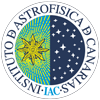Fernando Atrio Barandela

Stay at the IAC: 09/01/2014 to 06/03/2014.![]()
Research line: Cosmology and Astroparticles
Dr. Atrio gave a Seminar at the IAC on 2014 February 27th entitled Searching for Missing Baryons with WMAP and PLANCK.
Currently Dr. Atrio is Professor of Theoretical Physics at the Universitity of Salamanca (Spain).
Former PhD student of the Instituto de Astrofisica de Canarias, he obtained his PhD in 1991 by the University of La Laguna. From 1992-95 he was a post-doc at the Center for Particle Astrophysics at the University of California at Berkely before being appointed Associate Professor at the University of Salamanca in 1996.
His main field of research is Cosmology and Large Scale Structure. He is member of the Planck Collaboration and the Euclid Consortium. His research interests are the analysis of Cosmic Microwave Background secondary anisotropies generated by clusters, the search of missing baryons through the detection of the Warm-Hot Intergalactic Medium contribution to CMB temperature anisotropies and models of Dark Matter and Dark Energy. He is the author of more than 100 refereed papers with close to 4000 citations.
During his visit to the IAC Dr Atrio worked with the IAC staff searching for the Warm Hot Intergalactic Medium signature on the recently released Planck data of Cosmic Microwave Background Temperature Anisotropies.
During this stay they worked to obtain a detection using three different techniques:
- Computing the angular power spectrum at different frequencies
- Cross-correlation with templates that trace the dark matter distribution in a volume of ~100Mpc around the local group
- Monte Carlo Markov Chain parameter fitting to the data.
These techniques have shown to be viable when applied to WMAP data, as shown in different publications: Hernández-Monteagudo, Génova-Santos & Atrio-Barandela (2004), Génova-Santos et al. (2009) and Génova-Santos et al. (2013).
The derived results indicate tentative evidence for this signal, when Planck maps are correlated with templates built from the 2MASS survey which trace the WHIM spatial distribution. However, as the statistical significance of the signal is not sufficiently high, they prefer to derive upper limits, from which the physical conditions (density and temperature) of the WHIM are constrained. These results have been included into a paper that has been submitted to The Astrophysical Journal for publication. It is still being refereed.


